|
Captain C.F. Bond, U.S. Army Air Corps, was junior among
the three officers who landed their single-seat Boeing P-26 “Peashooters” at
Davis-Monthan Airfield shortly after noon on May 15, 1935.
Departing Tucson the same day, the trio was in transit from
March Field, Riverside, California, to El Paso, Texas (probably
Biggs Field), yet another stop along the way to their final
destination of Shreveport, Louisiana. Bond and his companions
left no clues in the Register as to the purpose of their
trip, which may have simply been an aircraft familiarization/delivery
flight from Boeing’s Seattle factory to
a squadron billet at Barksdale Field (Note 1, see notes section, below).
1st Lt. C.F. Bond, C.O. of the 321st Observation Squadron
(Reserve), Pearson Field, Vancouver, WA, 1929-33. As Captain,
he reprised his role as airfield commander in 1938-40.
Photo Pearson Air Museum (Alley, P.58)
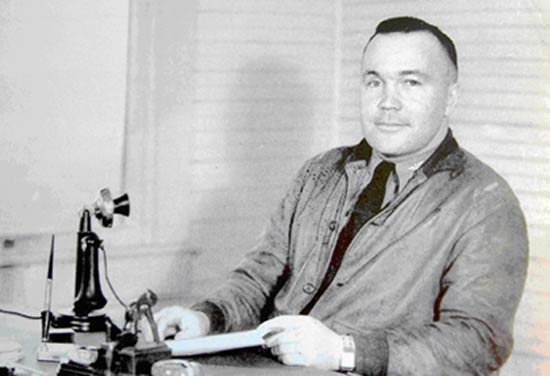 |
Morning Oregonian, Wednesday, June 12, 1935 (Source: Woodling)
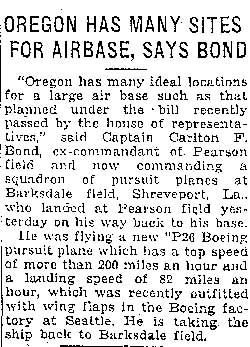 |
His flight through Tucson was, indeed, a ferry flight as documented in the Morning Oregonian of Wednesday June 12, 1935 (right). A series of P-26 aircraft were modified with wing flaps to improve low speed handling during landing. They were in the process of being disbursed from the factory to their duty stations.
Another brief article supporting the ferry appeared in the Air Corps Newsletter for January-July, 1935, below.
Air Corps Newsletter, January-July, 1935 (Source: Woodling)
Barksdale Field, La., May 9th. (1935)
The P-26 airplanes now on hand are being equipped with flaps by the Boeing factory at Boeing Field, Seattle, Wash. Ten are now at the factory and three more are being ferried
to replace those now ready for delivery. |
The subsequent activities of Capt. C.F. Bond’s companions,
Maj. Oliver P. Gothlin (flying 33-50) and Lt. Col. Millard
F. Harmon (33-49), are perhaps better known. Bond himself
piloted A.C. 33-58, possibly indicating a small production
run assigned to the same operational unit. Gothlin, a co-founder
of the Order of Daedalians, made three landings at D-M between
October 1927 and his last visit, this one, on May 15, 1935.
Harmon, later Major General commanding US Army Air Forces
South Pacific during WWII, was a D-M “regular”—registering
17 landings between January 1928 and May 15, 1935. For whatever
reason, this landing was the final for all three Army
fliers to Davis-Monthan Airfield. In the case of Bond, it
was his only recorded visit (2).
Despite being outranked by his traveling companions that
hot spring day in 1935, Carlton Foster Bond was no neophyte.
Quite well known in the late 1920s through the late 1930s
in the Pacific Northwest, Bond held the unique distinction
of being the only two-time commanding officer of the Army
Air Corps’ Pearson Field in Vancouver, Washington (see
the photo gallery below).
Gravitated to Ballooning
News item in The Bridgeport Telegram identified C.F. Bond
as an Army back-up pilot in the 1922 Gordon Bennett Cup
balloon race in Geneva, Switzerland.
 |
Born in 1893, Carlton F. Bond joined the Army in 1916 and
served in the Mexican Border Campaign. During WWI, Bond graduated
in one of the first classes in the aviation section of the
U.S. Army Signal Corps. During the early 1920s Bond gravitated
toward lighter-than-air craft and became a key member of
U.S. Army teams competing in important ballooning events
in the U.S. and abroad.
An item, left, in the sports section of The Bridgeport Telegram (Connecticut)
on June 22, 1922, named Bond as one of three back-up pilots
for the American Team in the famed Gordon Bennett Cup race
of 1922.
A broader retrospective article, below, from the Sunday Oregonian of July 17, 1932 documents his participation in the Race at Geneva, Switzerland in 1922. The conditions of their disqualification from the race are documented in Bond's own hand on the official Free Baloon Log Sheet.
Sunday Oregonian, July 17, 1932 (Source: Woodling)
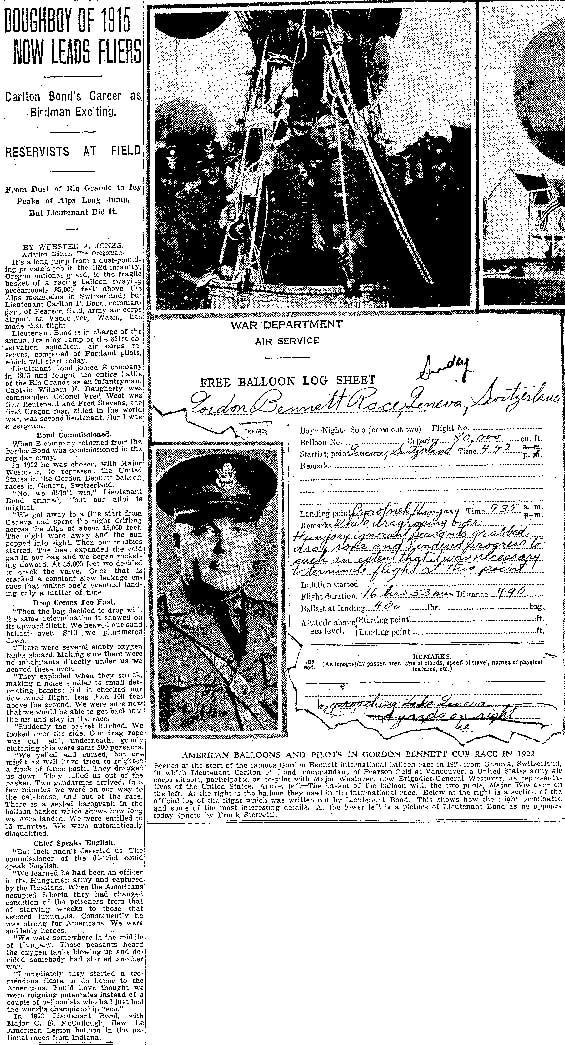 |
The Elimination Match that Almost Did
More than a year later, the July 4, 1923 edition of The
Fresno Bee (Fresno, California) (“Giant Gas
Bags Ready for Race; Records Expected”), mentioned
Carlton Bond of Aberdeen, South Dakota, in its listing
of four two-man teams fielded by the U.S. Army. Lifting
off from the Indianapolis Motor Speedway at
The July 4, 1923 Fresno Bee named
the participants of the National Elimination Race. The
lead-off crew listed here, one of the American two-man
teams that did enter the 1923 Gordon Bennett Cup, were
among 5 people killed in the deadliest race in that event’s
history.
 |
five-minute
intervals starting at 4:00 PM, a $1,000 first prize and
lesser purses were offered to the teams achieving the greatest
distances regardless of duration. A total of 14 balloons—four
each Army and Navy, and six civilian—comprised the
field. The purpose of the contest was to identify the top
three U.S. balloon crews that would enter the Gordon Bennett
Cup race in Brussels, Belgium, late that September. Perhaps
it was fortunate that Lt. Bond’s team did not make
the cut (3).
Weather reports predicted that the balloons would drift
in a northeasterly direction from Indianapolis toward the
Great Lakes and Canada, however, this is not how events played
out. Two weeks later, the July 21, 1923 Wisconsin State
Journal reported the harrowing experience of Capt. Charles
F. McCullough, pilot, and Lt. C.F. Bond, aide, who were obliged
to jettison everything in order to save themselves after
their balloon was “crushed flat” at 20,000’ by
converging storms near Pittsburgh, Pennsylvania. The intrepid
aeronauts managed to land safely in a tree.
Twice C.O. of Pearson Field, Vancouver, Washington
What began as the polo field for Vancouver Barracks evolved,
by the mid-1920s, into one of the premier Army Air Corps
installations on the West Coast, largely through the efforts
of Bond’s second predecessor, Lt. Oakley
G. Kelly (4).
Renamed Pearson Field in 1925 by order of the War Department
(5),
the location has seen few extended lulls in aerial activity
since balloonist Lincoln Beachey first landed there on September
19, 1905. Today, some 102 years later, Pearson Airpark functions
as an active municipal airport (identifier: VUO), although
military operations have long since departed (6).
From 1929-33, Pearson Field operated under the command of
1st Lt. C.F. Bond, who (at least initially) also commanded
the 321st Observation Squadron. Aircraft flown at one time
or another during this period appear to be a mixed bag of
Curtiss JN-4s, DeHavilland DH-4s and Consolidated PT-1s.
By 1930, more modern equipment joined squadron operations,
including PT-3As, Douglas O-2H and Douglas O-38 aircraft.
Lt. Bond’s first duty assignment at Pearson was marked
by rapid expansion of commercial operations on the field,
accompanied by much political intrigue between Vancouver,
Washington and its neighbor across the Columbia River, Portland,
Oregon. The fight was over the future of commercial aviation
operations in the area. Around this time the Chamber of Commerce
Field, as Pearson’s civilian sector was called, began
to live on borrowed time. Unable to compete with big money
interests bent on luring airmail contracts and other lucrative
businesses to Portland’s new Swan Island Airport, Pearson’s
civilian field started to lose its previous stature as the
region’s premier commercial airfield.
Meanwhile, military operations continued. Bond’s first
stint as airfield C.O. saw the unscheduled visit of the Land
of the Soviets. Suffering a malfunctioning oil pump
on its port engine, the giant ANT-4 all- metal monoplane
landed at Pearson on October 18, 1929. Pearson Field mechanics
repaired the pump, and the ship departed the next day for
San Francisco, before winging east to complete its historic
Moscow-to-New York flight.
In 1931 the 321st took to
the skies in search of Russell Cunningham, an airmail pilot
who went down in southern Oregon due to icing. Lt. Bond led
the aerial search for the man, who fortunately hiked his
way out. Flying a Douglas O-2H, Bond led another search later
that month for a missing Varney Airlines pilot, Walter Case,
who proved not so lucky. In February and March, Bond flew
in supplies to a U.S. Geodetical Survey team who had snowshoed
into the mountains to study the Columbia River and its tributaries.
These activities were typical of the type of flying required
of Bond and the 321st in their role as an Army reserve squadron.
Toward the end of Bond’s first stint as airfield commander,
the 321st passed to an officer two ranks superior
to Lt. Bond, Maj. Howard French. (See photo below.). The
reason for this is not given, although it is possible that
Bond’s increased work load due to expanded civilian
and military activity at Pearson necessitated the move.
Not much is written of Carlton Bond’s activities after
his 1929-33 stint at Pearson. The Davis-Monthan Airfield
register reveals one clue: Bond himself indicated that in
May 1935 Barksdale Field in Shreveport, Louisiana, was his
home field. However, after a four-year absence, Carlton Bond,
now a Captain, returned in 1938 to Pearson Field to again
take command, a post that lasted until 1940 (7).
Salina Journal, December 19, 1942 (Source: Woodling)
.jpg) |
A small, "looking back 20 years" article, left, that appeared in the Salina Journal of Wednesday, December 19, 1962, places Bond as commanding officer of the Smoky Hill Field facility in 1942.
Afterword
The sources listed below provide few details about Carlton
Bond’s 40 years of post-Pearson activity. It is noted
that he served at various posts around the world and retired
from the U.S. Air Force with the rank of Colonel on January
5, 1948 (a few months before the retirement of Col. Oakley
G. Kelly). Col. Carlton Bond’s name pops up in
connection with a 1965 Odd Fellow’s convention in Newport,
Rhode Island, but at some point he returned to the Pacific
Northwest and lived in Vancouver until he died on February
5, 1980. Far from complete, the story of C.F. Bond will be
updated as further information surfaces, particularly regarding
his WWII service and subsequent 32 years of retirement
following 32 years of active military duty..
For Further Investigation: Other Pearson Field/Davis-Monthan Connections
Several other pilots in some way associated with Pearson
Field are found among the signers of the Davis-Monthan Airfield
register. In addition to Oakley G. Kelley, these include
Jimmy Doolittle, John Gilbert “Tex” Rankin and
Vance Breese. For further information about these individuals
and their activities, readers are encouraged to explore the
sources and links below.
---o0o---
Notes
1. Manufactured by the Boeing Airplane Co. of Seattle, WA,
the P-26 was the Army’s first all-metal mono-plane
fighter. P-26 operations at Davis-Monthan Airfield were common
enough in the mid-1930s that airfield manager Dewey Simpson
thoughtfully stored spare P-26 wings in the rafters of the
(1932) hangar as a hedge against the hot little ship’s
tendency to ground loop because of its narrow-track landing
gear. (Source). The link mentions Simpson's activities at Davis-Monthan Airfield.
2. All information relating to these three officers and
their flight through Tucson is searchable by name, aircraft
type and aircraft number from the homepage of
the Davis-Monthan Airfield Register website.
3. The Gordon Bennett Cup race, ballooning’s most
prestigious event, was first held in 1906. The 1923 Brussels
event was the bloodiest ever held. A portion of the event
appears to have survived on 87’ of film, summarized
as: “Five
out of 15 balloons met with disaster after starting from
Brussels...Mrs J. Dunville’s Banshee III (British)
descended in safety...at the outset the American Army Balloon
collided with a Belgian...the American pilots, Lt. Olmstead
and Lt. Choplaw, cleared the Belgian, but were later killed
at Niestelrode (Holland). The Gordon Bennett balloon race
at Brussels, during which five were killed in a storm, was
filmed by Yates.” ( Source this is a 1:37 YouTube video. Not identified as Yates' film).
4. Lt. Oakley G. Kelly, famed non-stop transcontinental flyer,
was an able commander whose visionary administration was
instrumental in developing Pearson Field into one of the
West Coast’s leading Army and civilian facilities.
Kelly, who commanded the 321st Observation Squadron at Pearson
from 1924-28, tirelessly promoted aviation in the civilian
sector. Under Kelly’s tenure as field commander, commercial
growth burgeoned on the field.
Kelly’s successor, Bond’s immediate predecessor,
was Capt. Aubrey I. Eagle, who commanded the field from 1928-29.
Born in 1879 in Texas, Eagle appears in a number of news
accounts in the 1920s. In August 1922, he is in Dayton, OH
on the eve of testing his own “flivver” design,
intended to provide affordable air transportation to Everyman.
Other accounts have Eagle posted to Bolling Field (Dec. 1923),
San Antonio from the Philippines (Oct. 1926) Crissy Field
(Nov. 1927) and Langley Field from Ft. Leavenworth (May 1929).
In July 1927, Eagle and Capt. Wm. P. Erwin tossed their hats
into the ring to fly the first mainland US-to-Manila flight.
In March 1929, just after his Pearson tour, Eagle was one
of the Portland, OR “Quiet Birdmen” personally
invited to attend the wedding of Charles Lindbergh. In July
1953, Eagle, 73, fell out of a rowboat on the Klamath River
in northern California and drowned. The 7/29/53 Fresno
Bee item announcing his death said Eagle was reputed
to be the first man to talk by radio from an airplane to
the ground. It also revealed that Eagle Field, a WWII primary
training field near Dos Palos, Calif., was named in his honor.
See this link.
5. Lt. Alexander Pearson, Jr., stellar pilot and record
holder whom fellow McCook Field test pilot Jimmy Doolittle
held in utmost regard, was memorialized by the War Department’s
General Order No. 9 on May 7, 1925. The order officially
redesignated “the landing field at Vancouver Barracks,
Washington” as Pearson Field in honor of Pearson who
was killed at Fairfield, Ohio the year before during a practice
flight of the Curtiss R-8 racer for the 1924 Pulitzer Trophy
Race. Pearson, a Kansas native and University of Oregon graduate,
never operated on the field that bore his name, but his flying
younger brother, Lt. William Pearson, did serve there. Lt.
William Pearson may well be the enigmatic “Lt. Pearson” who
signed the Davis-Monthan Register on February 20, 1932, one
of seven Army P-12 pilots on a round-trip flight from March
Field, Riverside, California. Oakley Kelly’s transcontinental
partner, John Macready, was another member of that small,
exclusive club of McCook Field test pilots during the time
Pearson and Doolittle were there.
6. Pearson Field hosted military operations from about 1920-21
until WWII, when the 321st Observation Squadron, a reserve
outfit, moved to larger quarters. In 1949, the Army deeded
its portion of the field to the City of Vancouver, which
then named it Pearson Airpark. Over the years, Pearson was
the scene of many notable “firsts,” including
the landing of the nation’s first interstate airmail
flight in 1912 and the conclusion of the world’s first
transpolar flight, by the Soviet ANT-25, in 1937. Tex Rankin’s
popular flying school operated on field from 1924-26 and
produced several prominent aviatrixes, including Dorothy
Hester and Edith Foltz. Pacific Air Transport, another early
Pearson-based operation, inaugurated the first West Coast
air mail service between Seattle and Los Angeles on Sept.
15, 1926.
7. In 1941, the National Guard Board authorized the 321st’s
successor, the Oregon-based 123rd Observation Squadron. On
the eve of WWII, the squadron was federally activated under
different unit designations flying the O-47, BC-1A and later
the F-5 photo version of the Lockheed P-38 in the CBI and
ETO. Redesignated after the war as the 123rd Fighter Squadron,
the unit, which became the 142nd Fighter Interceptor Group
during its Korean War service, today flies F-15A/Bs as the
Oregon Air National Guard’s 142nd Fighter Wing (Source).
8.Anyone having knowledge of C.F. Bond’s whereabouts
and activities during his inter-Pearson years (1934-37) and
his post-Pearson period (1940-80) is requested to please
use this FORM to contact us .
---o0o---
Photo Gallery
Neatly arrayed 20th Pursuit Group
P-12s at Pearson Field, June 1931. Pearson was a much-used
stopping-off point for aircraft in transit. The 20th Pursuit
Group, fresh from the Air Corps’ massive national exercise
at Dayton, Ohio in May 1931, stopped at Pearson on its
way home to Mather Field, Sacramento, California. Compare
main buildings in this photo with recent color photo below.
(source: Walker). Photo: Pearson Air Museum (Alley, P.53)
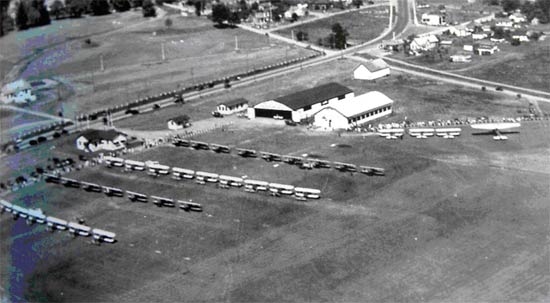 |
Officers of the 321st Observation
Squadron (Organized Reserve) pose with their Douglas O-38s
during 1933 summer maneuvers. Squadron C.O. was Maj. Howard
French (2nd from left, back row). Pearson Field base commander
was 1Lt. Carlton F. Bond (4th from right, back row). Bond’s
first tour as airfield C.O. ended in August 1933 (Source:
Walker), shortly after this photo was taken. Photo: Clark
County Historical Museum, P.0008.004.9. (Alley, P.64)
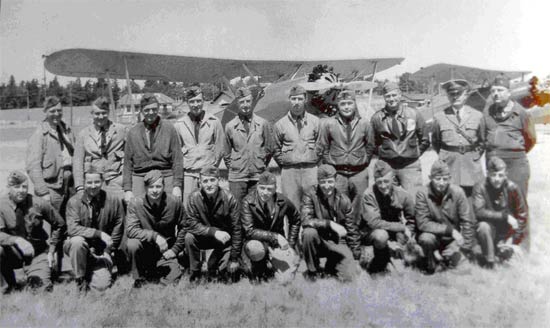 |
Pearson Field-based Douglas O-38s
of the 321st Observation Squadron over Mt. Hood, Oregon.
Photo, if correctly dated as 1928, was taken during Capt.
Aubrey I. Eagle’s command.
Photo: Pearson Air Museum (Alley, P.60)
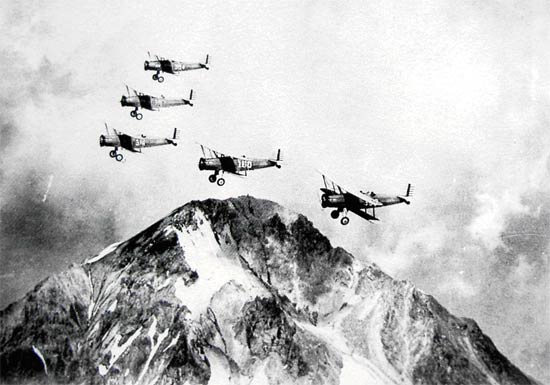 |
Pearson Field, July 2007. At far left
is the former spruce mill office refurbished by Lt. Carlton
Bond as the HQ of the 321st Observation Squadron. Center,
the rebuilt main hanger, destroyed by fire in 1976, houses
the main part of the Pearson Air Museum. Built in 1918,
the original historic hangar, right, which claims to be
the second oldest wooden hangar in the U.S., briefly housed
Italian POWs during WWII. Peeking through the haze, some
50 miles distant (upper right), is Mt. Hood, Oregon—named
in 1792 for Admiral Samuel Hood, 1st Viscount Hood, also
the namesake of HMS Hood, sunk in 1941 by the German battleship
Bismarck.
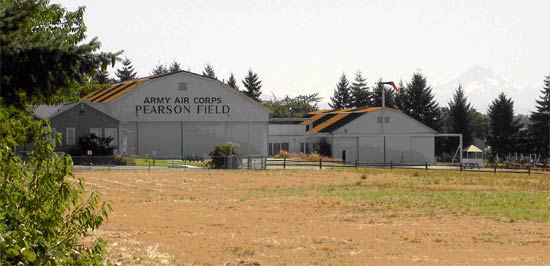 |
¾ life-size bronze of C.F. Bond “honoring aviation pioneers” welcomes
visitors to the Pearson Field Air Museum, Vancouver, Washington.
R.W. Bane sculpture. Color photos by M. Gerow.
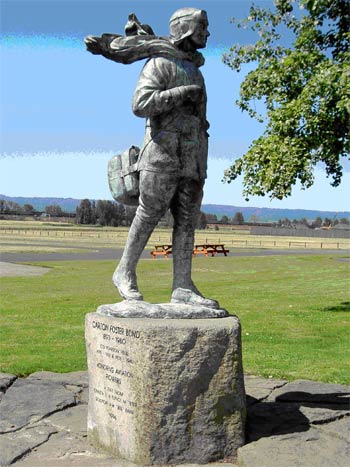 |
---o0o---
I have very little information regarding Bond's service during WWII. Below, received from a site visitor whose grandfather served with Bond during WWII, a commendation letter to the grandfather signed by Bond. "APO 241" was located at the Kwajalien Atoll, in the Marshall Islands in the South Pacific in 1944. The commendation is self-explanatory, and rewards a job well done with a recommendation for promotion.
Commendation, October 31, 1944, Signed by Bond (Source: Site Visitor)
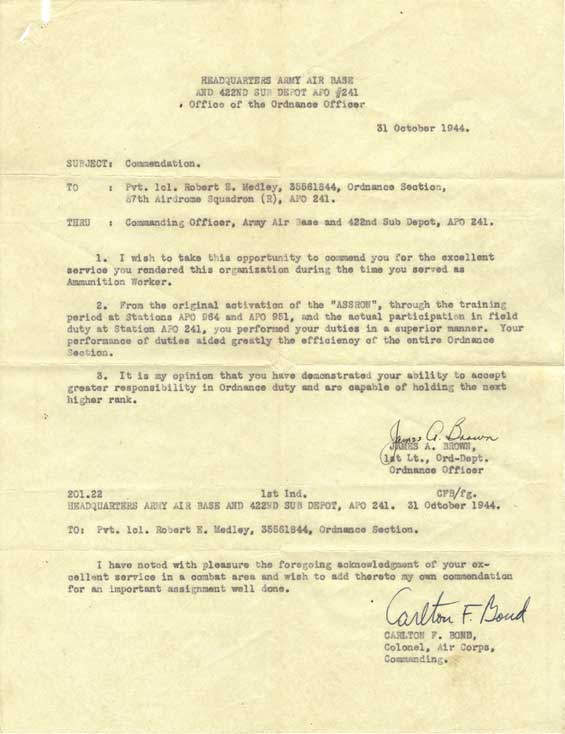 |
If you have further information regarding Bond's WWII service and beyond, please let me KNOW.
---o0o---
THIS PAGE UPLOADED: 08/17/07 REVISED: 03/04/13, 03/12/13, 12/15/21, 01/11/23
|







.jpg)





